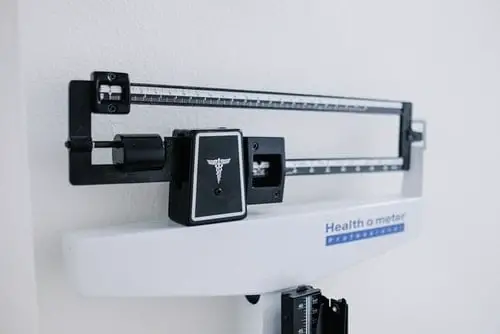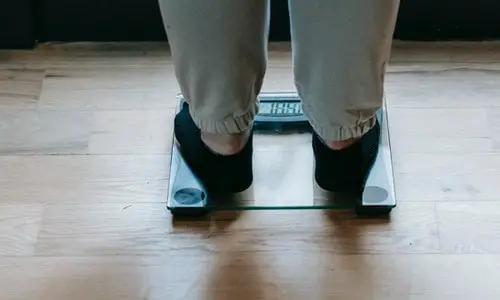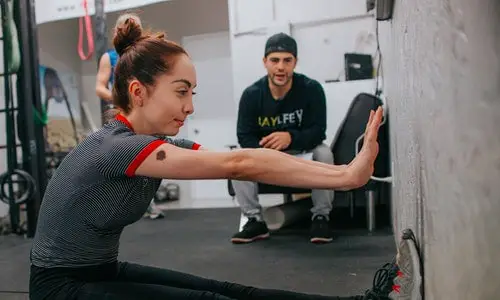Want results from your training? Then you’re going to need to be measuring yourself, otherwise, you’re just guessing, and that’s a fast track to failure.
But, if you’re training with a personal trainer, the good news is that they’ll do all of it for you!
You don’t need to be nervous about trainers taking measurements, none of them hurt, but if you’re still curious about how they are going to be poking and prodding you, I’ll be going through a complete list of personal training body measurements, so you will be fully prepared for them.
It’s a normal part of what personal trainers make you do in order to be certain that the training they are providing is working, so there’s nothing to be nervous about.
Sound good?
Let’s go…
I know a lot of my clients used to get nervous around measurement time, which is silly because they knew there was nothing to be nervous about.
If you’ve just started your personal training journey and you’ve not had any fitness measurements taken yet, you might be a little curious to know what you are in for, so this is fair enough.
Today, I’m going to list out all the measurements that personal trainers take, how they are done, and really importantly, how they benefit you.

Top 5 Measurements Personal Trainers Take
Bodyfat measurements

Bodyfat measurements simply measure how much fat you have underneath your skin. Body fat is what most people want to keep to a minimum in order to maintain or attain a lean physique. Healthy body fat levels for women are between 25-30 and 18-24% for men.
How will they measure it?
Body fat levels are one of the measurements for personal training clients that can really help assess the progress of a training regime. There’s no way of being 100% accurate with any test, but they give you a pretty good estimate of where you are currently at.
They are:
- Bioelectrical impedance scales
- Skinfold calipers
- Tape measurements
Bioelectrical impedance scales
Bioelectrical impedance scales may sound terrifying, but they are pretty simple. You step onto a set of scales and your trainer will plug in a few details, such as your age, height, sex, and perhaps a few more depending on the brand of scales.
You’ll hold onto a small handle attached to the set of scales and a very low current will be passed through your body. Whenever the electrical signal comes up against resistance (from bone or muscle), it sends a message back to the scales.
After a few seconds, it will have completed its scan and should give you a whole bunch of stats, things like, body mass index, skeletal muscle levels, weight, and obviously bodyfat %.
Please believe me that you will not feel the current at all, and it definitely doesn’t hurt.
Skinfold calipers
Nice and simple this one, but one of the more physical measurements personal training can offer. Your trainer will take a small pair of calipers and pinch your skin (very lightly) between their thumb and forefinger. Then they’ll open the calipers and gently close them on the skin. The distance between the tips of the calipers is measured and noted down.
This test can be done on several sites of the body, with more areas being tested usually resulting in more accurate readings.
After a few calculations, your trainer should be able to give you a pretty good estimate of your body fat levels.
Tape measurements
Similar to the skin fold caliper testing, your trainer will take a tape measure and take the circumference measurements of several sites on your body, usually areas like your waist, thigh, upper arms, etc. After a few calculations are made, you should again get a fairly good estimation of your body fat levels.
Circumference

Circumference measurements are useful for people trying to lose weight as explained above, but they are also really important for people trying to put on muscle.
Losing fat is a lot faster than gaining good weight from muscle alone, but testing the starting points for both goals is equally important.
A basic circumference test will include your trainer using a tape measure to make measurements from multiple points around the body, usually the waist, the thighs, the upper arms, and the chest. They’ll jot these numbers down and repeat the test every six to eight weeks.
By building up a database from your results, your trainer will be able to clearly see if you are making progress in your training or if they need to adjust your regime.
Weight

Weight measurements are a classic way for your trainer and yourself to track your progress.
At the start of any training program, your trainer should take your weight and make a note of the time it was taken. They should also ask you to take your own weight first thing in the morning after you have used the bathroom, this is the most accurate time to weigh yourself.
It’s easy to keep stepping on the scales every day when you’re on a weight loss journey, but as any good trainer will tell you, this is a waste of time because your weight can fluctuate pretty wildly from day to day.
A lot of trainers are moving away from taking regular weight measurements because it can cause a lot of frustration and disappointment. During a weight-loss journey, your actual body weight may not change much at all, whilst your body fat can decrease substantially.
You will look very different, your clothes will fit better and you’ll be much happy with your shape, but because you may be adding muscle to your body (which weighs more than fat), you can see little to no change on the scales.
This can make a lot of trainees feel like their efforts are a waste of time, when in fact, they’re working fantastically. So using the scales as a measurement of progress is not the best route to take.
Flexibility

Who cares about flexibility eh?
Well, your trainer probably cares about it a lot more than you do, but it’s a pretty good measurement of the progress you are making in your training.
By becoming more flexible you will reduce your chances of injury, improve your posture, and can increase your strength and certainly your shape. You’ll usually find that your trainer will be putting exercises into your training program that help improve your flexibility without you even knowing about it.
For example, a lunge works all your lower body, which is great, but it also stretches the muscles on the front of your legs that attach onto your hips which when tight, can lead to lower back pain and bad posture.
Your trainer will test your flexibility by using sit and reach tests, trunk rotation, and a bunch of other simple tests to see how you’re improving. You’ll be quite surprised by the improvements you’ll see in your flexibility in a just few weeks.
Body Mass Index
Ok, so we’re onto the final and most controversial of the bunch here with BMI testing.
The BMI calculation divides an adult’s weight in kilograms by their height in metres squared. For example, A BMI of 25 means 25kg/m2.
Source www.nhs.uk
You’re probably wondering why I said it was the most controversial of the bunch, well, it’s because I really don’t think it’s that good of measurement at all.
In fact, whereas I almost always recommend you find a trainer that tests and measures, in the case of BMI testing, I would actually suggest your find a trainer who doesn’t use this test.
The reason BMI is such a crummy way of measuring anything is that it doesn’t take into account muscle weight.
It works on the assumption that a person of a certain height should be within a certain weight range to be “healthy”.
Well, as you’ve hopefully noticed from above, your weight can mean nothing when it comes to how healthy you are. For example, I am a man of short stature, standing at an almighty 5’5, but I’ve worked with weights for a long time and packed on a lot of muscle, which weighs a lot.
When I measure my own BMI I come out with a score of 27, which puts me in the overweight category. I currently have a body fat of around 15%, so you can see why I don’t agree with this as a measurement tool.
Doctors used BMI as a very quick way of deciding if a person was “healthy” or not, but even they are moving away from this method due to its inaccuracy, so a quick tip here is to avoid trainers who still use this method of measurement, it’s just not any good!
Conclusion
Your personal trainer should be using at least one of these measurements with you fairly frequently, usually around every six to eight weeks.
Hopefully, this article has shown you that there’s nothing to be nervous about when your trainer says they are going to be taking some measurements, it shows they care about getting you the results you’re paying for.
There may be other measurements your trainer might like to use, but everyone is different and has their own preferences. During my time as a personal trainer, these measurements are the ones that I used most frequently with my clients (with the exception of the BMI of course).
Now go take those measurements, train real hard and get some great results!
Go get ’em!
If you enjoyed this article and feel it might help others, please feel free to share it or link back to it.

